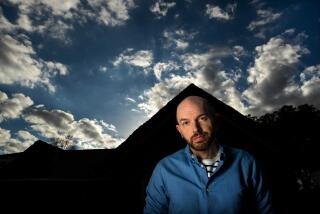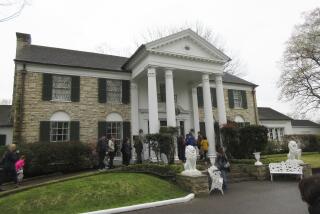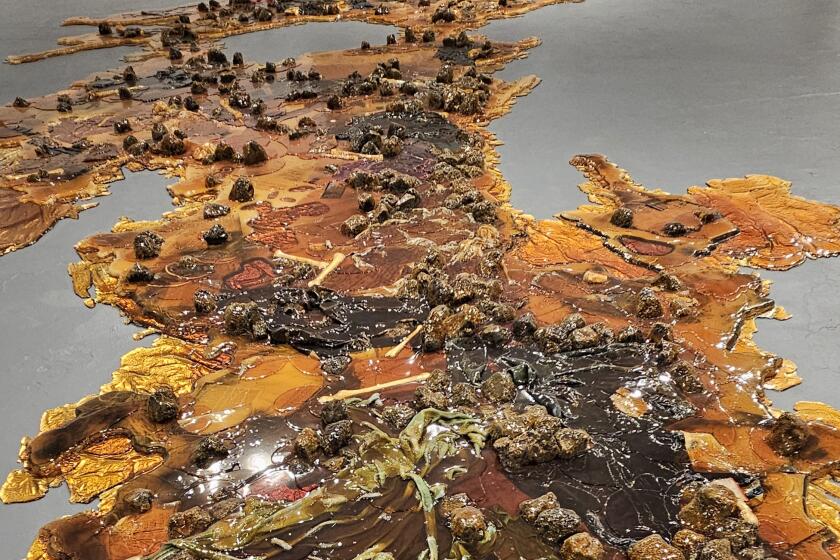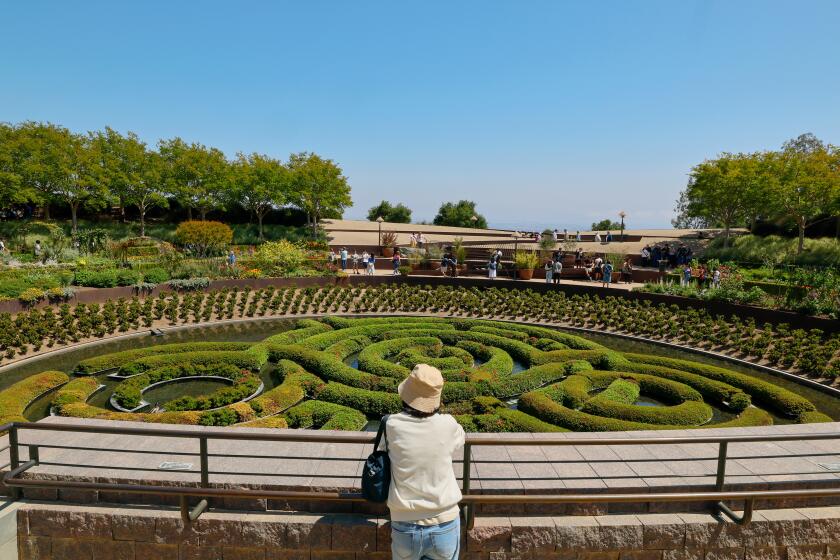STAGE : It’s a Plaid, Plaid World : A little idea for a ‘50s musical revue has proved a grand design; in city after city, ‘Forever Plaid’ becomes a cottage industry
Stuart Ross had this idea for a show about a ‘50s quartet that sings beautiful love songs but knows nothing of love. Workshops came and went, and so did producers. He didn’t know how many more stuffed dogs, bow ties, Hula-Hoops, suitcases, microphones and printing or fire-eating-fluid bills he could put on his credit cards.
He’d hit around $8,000 worth of charges by the time producer Gene Wolsk happened into the New York cabaret where “Forever Plaid” was shaping up. Wolsk, who earlier co-produced such hits as “Driving Miss Daisy,” figured that with a few more musical numbers, fancier lights, better costumes and props, “it could be very successful commercially.”
You bet it could. Two years later, Ross’ $8,000 deficit has spawned a multimillion-dollar enterprise. His musical revue is still running in New York, as well as in Minneapolis, Boston and Denver. It is selling out at the third Southern California theater to book the show in less than a year. Five more U.S. companies are expected to open by year-end, with talk of future tours in Asia and Europe.
Mellow music, clever staging and silly patter from a reincarnated harmony group has launched a cottage industry for Ross, Wolsk and associates. Clearly inspired by the merchandising success of Cameron Mackintosh’s “The Phantom of the Opera” and “Les Miserables,” presenters here and elsewhere have turned their theater lobbies into mini-boutiques.
“Forever Plaid” producers have added such things as plaid bow ties and cummerbunds to the traditional CDs, sweat shirts and such. “Frequent-plaid programs” reward repeat visitors in some cities, while Ross is peddling everything from a guidebook to music video. Already under way is a lucrative sideline that packages chunks of “Forever Plaid” for trade shows and other buyers.
It helps, of course, that the show’s a major hit here and elsewhere. Ticket sales alone are nearly $7 million, Wolsk says.
“Forever Plaid” was the biggest seller in San Diego theater history. It sold out at the Pasadena Playhouse. And Beverly Hills’ Canon Theatre is now booking group sales for the fall.
“We broke box-office records with ‘Love Letters,’ and this is doing 40% more business,” says Joan Stein, a co-producer on both shows.
From the plaid marquee out on Canon Drive to the plaid floral arrangement in Stein’s office upstairs, nostalgia with a gimmick is paying off. “Forever Plaid’s” four fictitious singers were en route to their first big gig in 1964 when their car got in the way of a school bus filled with parochial-school teens heading for “The Ed Sullivan Show.” Back on Earth for one performance only, the Plaids are now making what one of them calls “the biggest comeback since Lazarus.”
Tossing off such lines as “the sentiments of that song, while peppy, are true,” the Plaids take what Ross calls “four-part guy groups” sweetly into self-parody. They write song lyrics on their hands, dedicate numbers to “all of you who have ever been to a prom” and incorporate choreography that includes rippling hand movements to “Three Coins in the Fountain.”
Exaggerated choreography and other offbeat staging also distinguish “Forever Plaid” from more traditional ‘50s fare. And who better to satirize the period than someone too young to be caught up in it but old enough to have watched it, sometimes painfully, from the sidelines. Ross, 39, even first called the show “Butchwax”--the name of the hated hair product he used on his hated crew cut.
Ross knew his harmony groups cold. He’d heard their music and hoarded their albums since he was a preschooler and his older brother went off to college. Ross acquired his older brother’s collection of 45s, then added to it with discards from the jukebox at the Ross family’s diner.
His affection for the period stayed with him through years of writing or directing comedy for everything from industrial revues (for IBM and other firms) to Broadway (the Tony-nominated but short-lived “Starmites”).
“Forever Plaid” took plenty of time to evolve into the show now at the Canon. For two years, it played assorted cabarets, hotels and theaters in Upstate New York, Manhattan, Chicago, even St. Croix in the Virgin Islands. It was a 45-minute set of songs at one point, a play with music at another. The Plaids were alive, then dead, alive and dead again.
One version featured heavy-metal music, stage smoke and such lyrics as “love ain’t a many-splendored thing.” (That lasted one performance.) Another featured a Rosemary Clooney sound-alike as the voice of God, urging the Plaids to go forth and sing harmony. “Plaid Tidings” included Christmas music and a baby Jesus wrapped in plaid swaddling clothes.
Skits and songs also changed. Some numbers were cut because the producers couldn’t get the rights, says James Raitt, the show’s musical arranger. Raitt, who is singer Bonnie Raitt’s cousin, adds that such quick parodies as “Bess, You Are My Girlfriend Now” from “Porgy and Bess” were dropped when they couldn’t get rights to use just a portion of a song without paying for the whole thing.
Other material simply didn’t work well, Raitt says. The Beatles’ refrain “She loves you, yeah yeah yeah” emerges as “She loves you, yes sirree Bob,” but a version of “Hound Dog” with corrected grammar was cut early on. Raitt says he did about 80 arrangements before he and his colleagues settled on the 20 in the show.
“It was a very long evolution,” says Raitt, who is credited in the show’s program with musical continuity, arrangements and supervision. “We kept trying different things until we found the right tone and feel.”
Things jelled in 1989 when Ross and Raitt were both encouraged and irritated by the success of other ‘50s takeoffs. An earlier version of the show had played Steve McGraw’s club in New York, and when McGraw’s came up with an offer, they really pushed. They pulled together several friends--including the four Plaids now playing in Beverly Hills--and started rehearsing in assorted apartments around New York.
Take-home pay was low--the performers donated everything above expenses to Broadway Cares, an AIDS charity--and Ross even hand-painted the plaid on the jackets himself with felt-tip markers. The four actors not only wore their own shoes and tuxedo pants, but they also took turns washing and ironing their shirts.
They kept going, they all say, because they simply loved the show. They’d turn up at McGraw’s late at night, often after other work or performances, and become the Plaids. “It’s not a sendup or spoof but a very special piece of theater,” says Guy Stroman, who plays Frankie in the show. “We wanted to attract a producer and word of mouth. Which happened.”
Wolsk wasn’t the only producer charmed by the show. Tom Hall, managing director at the Old Globe Theatre in San Diego, stopped in at Raitt’s suggestion, liked it and encouraged Old Globe colleagues to see it. “We all had a good time and felt it could move to a larger venue,” Hall says.
It took a while to persuade the producers that the show would work in a big theater like the 626-seat Old Globe, Hall says, but they quickly proved their point. Two weeks into its initial six-week run at the Globe last summer, “Forever Plaid” sold out the house. Demand for the show was so great, in fact, that the theater booked the group back over the holiday season for another 10 weeks, and, says Joe Kobryner, Globe marketing-sales director, opening-day advance sales were higher than sales during the entire original run.
Actors Stroman, Stan Chandler, David Engel and Larry Raben hardly had time to leave Southern California during the hiatus. The Pasadena Playhouse had an unexpected empty seven-week slot in its subscription season last fall and picked up the show. By its second week there, Pasadena too sold out the rest of the run, says executive director Lars Hansen. “Audiences loved it,” he says. “Every single performance received a standing ovation.”
The Old Globe had to close the show to make way for a subscription play, Hall says, but the theater is associated with the Canon production and shares in its revenues. “If it has a long and successful run,” he says, “it could mean a significant amount of money coming back to us. Given the nature of fund-raising and the economy right now, it’s important revenue. And we hope it does well.”
It certainly seems to be doing well. Veronica Chambers, who has been involved in TV production, and Stein, co-executive director of the Canon, say they raised $325,000 in two weeks (from 26 individual investors, including “just a handful” of industry people) to get the show up. Next week, says Stein, sales through June will break the $1 million mark.
“The show works wherever it’s been done,” says producer Wolsk. “It has that combination of wonderful music and harmony that one doesn’t hear much anymore. Even if people don’t walk out saying it has a big message, they are touched with the idea of people realizing their dreams.”
The grand silliness of a calypso medley, audience participation and an “Ed Sullivan Show” spoof no doubt helps boost audiences, but the heart of the show is its highly stylized and well-staged singing. Members of the original harmony groups have turned up from time to time, Ross says, noting that the Four Lads even said that “the Plaids sounded better than they ever did.”
While producers report a core audience of people from 35 to 55 who actually remember the music, the Old Globe’s Hall says they also received considerable repeat business from people in their early 20s to late 60s. “It’s (when) two generations or more listened to and enjoyed the same popular music,” says actor Chandler, who plays Jinx.
Nobody underestimates its value as escapist fare either. Says Sharna Lubin, there with her mother, Marion Gershman:”You sit down and for two hours it takes you away from everything going on in the world.”
That’s the goal, say producers, who are promoting lightheartedness from the plaid box office to the framed album covers and touched-up Marilyn Monroe photo on lobby walls. Usher Danique Day says people even tell her they had a great time as they leave.
It never hurts to offer souvenirs of that nice time, and Ross is a walking advertisement for “Forever Plaid” merchandising. On a recent Los Angeles visit, the New York-based playwright-cum-entrepreneur set off his jeans, tie and sport coat with a “Forever Plaid” pin on his lapel and watch on his wrist. Say the clean-cut playwright matter-of-factly: “It’s endless what we have.”
Again following the lead of such larger shows as “Les Miserables,” “Forever Plaid” keeps cloning itself. Ross, Raitt and other members of the creative team go from city to city, rehearsing each new company, building sets and generally recreating their show.
Coming to Los Angeles soon is what Ross calls “a frequent-plaid program.” Repeat visitors in other cities already receive assorted gifts, and Stein says the Canon will soon give away mugs, autographed cast photos and other items after as few as two visits.
Stein says she and co-producer Chambers plan “to paint the town plaid,” and few are the opportunities that the Plaids or their publicists ignore. Celebrity theater-goers are photographed at the Canon for the Plaid Hall of Fame, and earlier this month the Plaids serenaded Ivana Trump, visiting the Bistro Garden across the street on a book tour. Last Monday evening, they were at Dodger Stadium to sing the national anthem at the Dodgers-Reds game.
Ross estimates that there have already been 65 or 70 Plaids nationally, including understudies, and there is plenty to keep them busy. Since the show’s start, Ross has rewritten and customized chunks of the show for everyone from corporate sponsors to President Bush (at both the White House and Kennebunkport, Me.).
Featuring past or current performers from the various “Forever Plaid” companies, there have already been more than 30 charitable and paid performances of what Ross calls the Party Plaids. At prices as high as $25,000 per appearance, Plaids introduce new products and entertain conventions of travel agents and others. “When the President asked for 45 minutes, it was easy,” Ross quips. “We’re able to do it at a moment’s notice.”
What next for the Plaids? Possibly a “Plaid Tidings” Christmas show and record album. Ross will be at the Old Globe this summer directing Michael Cristofer’s new play, “Breaking Up,” and has been offered a commission to develop a Christmas show for that theater.
They may even be back in San Diego before Christmas. The Old Globe has an option to bring the show back later this year, says managing director Tom Hall, who figures the odds are about 50/50 right now. Says Hall: “I think there is still a good-sized audience for it here in San Diego.”
Ross, currently directing a revival of “It’s a Bird, It’s a Plane, It’s Superman” at the Goodspeed Opera House in East Haddam, Conn., plans to move to Los Angeles in June. He has an agent now and is peddling “Forever Plaid” projects that include a screenplay, a TV series, an animated cartoon and a music video. He’s also writing a “Forever Plaid” manual that features “tips on how to survive in the coming century and still be plaid.”
“We hope somebody (in Los Angeles) comes up with something concrete,” Ross says. “But if nothing happens, I’ll go do the movie or TV series myself. I still have my Visa card, and it’s all paid off.”
More to Read
The biggest entertainment stories
Get our big stories about Hollywood, film, television, music, arts, culture and more right in your inbox as soon as they publish.
You may occasionally receive promotional content from the Los Angeles Times.






